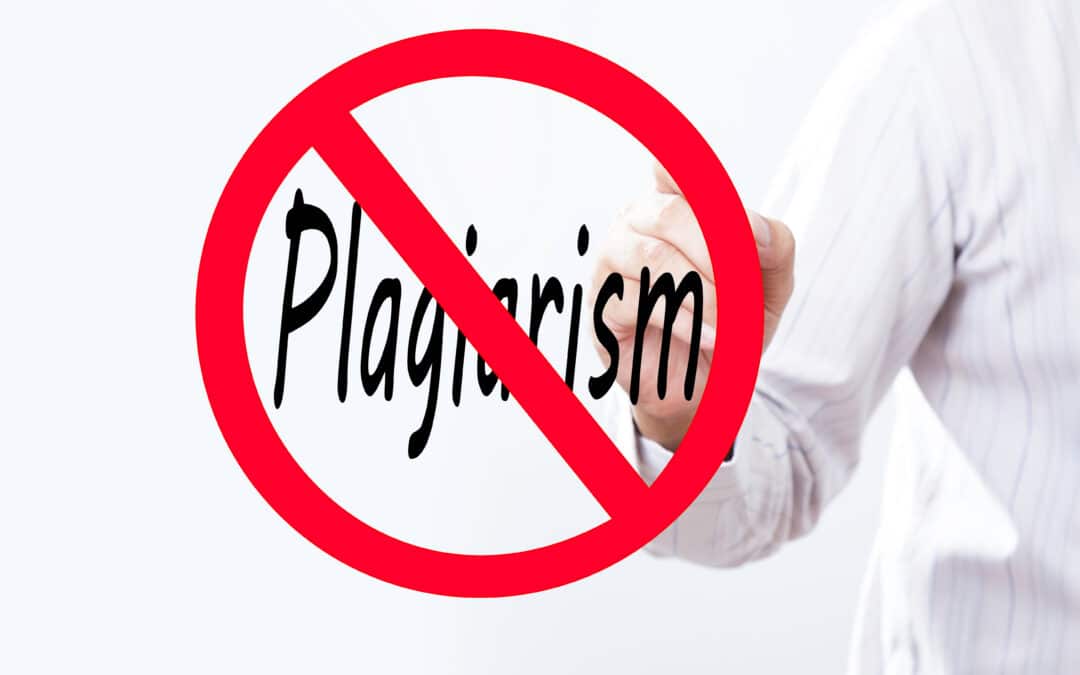One of the most important aspects to look out for in your content marketing is plagiarism. While the majority of the time marketers don’t set out to plagiarize material on purpose, it is something that people find themselves doing without even realizing it, especially when linking to or referencing the work of competitors. Whether it’s by forgetting to cite the source, neglecting to indicate that a particular sentence or paragraph is a quote or paraphrasing incorrectly, it all leads to the same result: plagiarism. In this article we discuss what plagiarism is, why it’s important to avoid plagiarism in your content marketing and several ways to steer clear of accidental plagiarism in your future content.
What Is Plagiarism?
Before we can begin to discuss how to avoid plagiarism in your content marketing, it’s important to understand what it truly is. Angela Harper from Joshua Lyons Marketing indicates that plagiarism is defined as taking “material from a website or publication and presenting it as your own without giving proper credit to the original author.” She goes further to say that there are three types of plagiarism: accidental plagiarism, paraphrased plagiarism and complete plagiarism.
Accidental plagiarism is just what it sounds like, an accident. This most often occurs when someone simply forgets to cite a source or author or neglects to put quotation marks around a quote. It is not intentional, however, while it may be just an oversight, it still is considered plagiarism and can have the same repercussions as the other two types.
Paraphrased plagiarism is when source material isn’t paraphrased completely. When you paraphrase something, the goal is to summarize the idea without using the exact words and structure of the original source. In cases of paraphrased plagiarism in your content marketing, some of the words or phrases may be changed, but the general structure of the sentence or quote remains the same. This type of plagiarism is tricky because there are many times that content marketers may feel like they’ve successfully summarized a quote enough, but it really isn’t as simple as replacing a word or two and calling it good. It’s much more involved than that. Later in this blog post we discuss ways to ensure that you have paraphrased source material correctly.
The last type of plagiarism, and the most egregious, is complete plagiarism. This is when source material from someone else is directly copied and passed off as your own work. The difference between this type of plagiarism and the others is essentially in its intent – it is done on purpose, with full knowledge that the material is copied. Hopefully this is not a problem that many marketing teams run in to, but it is important to be aware and on the look out for it as it can have quite serious consequences.
Why Is It Important To Avoid Plagiarism?
Beyond wanting to be an ethical content marketer who proudly creates their own work, there are many other reasons for the need to avoid plagiarism in your content marketing. According to Harper, the consequences can include a loss of trust from consumers, a destroyed reputation, loss of target audience, punishment in the form of fines or jail time and even repercussions from Google.
If one of your main objectives in content marketing is to build trust and a relationship with your audience (which it should be), just the idea of losing their trust and destroying your brand image should be devastating. Once consumers believe that your company has created any type of fraud you are unlikely to get them back as customers. Additionally, with how easy it is to share information on the internet and social media, you run the risk of your faux pas going viral and ruining your reputation to potential consumers as well. While it is possible, it can be incredibly difficult for businesses to smooth things over after being caught in this type of situation. Apologies can go a long way, but consumers have long memories and you don’t want your company to be associated with any type of plagiarism – accidental or otherwise.
If the idea of your business losing customers isn’t enough of an incentive to avoid plagiarism on its own, another factor to consider is the degree of punishment that can come from it. If it’s found that your content isn’t your own creation you can be fined quite a hefty amount. Some plagiarism crimes can even result in jail time. This monetary punishment and risk of jail are definitely worth making sure that you’ve avoided plagiarism in your content marketing.
One last reason to avoid plagiarism, and of particular note for content marketing, is the SEO penalties you may face if Google discovers you’ve used someone else’s work without correctly citing the original source. While there might not be a monetary punishment, there can be a loss of your SEO ranking. With SEO being such an important part of content marketing, you want to do everything you can to avoid a plagiarism mistake affecting traffic to your website.
How To Avoid Plagiarism In Your Content Marketing
The consequences of plagiarism are quite daunting, and the idea of being responsible for making sure your content marketing is free from any form of it can feel overwhelming, especially with such high stakes. There are, however, several different ways you can ensure your content is plagiarism-free. One of the easiest ways to do this is to simply quote the original material and cite the author or webpage. If you’re having trouble coming up with an original way of saying something, use quotation marks and cite which source it came from. This method is really fool-proof, and if you want to be as safe as possible when using source material from another person it’s definitely the way to go.
Despite the ease of quoting material, there may be times when using a lot of quotations can begin to feel a bit clunky in a piece of content marketing, particularly when you use a variety of quotes from different sources. It can be hard to make your content flow naturally when it’s broken up with so much quoted material. This is where paraphrasing comes in. Doing it correctly can be a little tricky, especially when you’re dealing with a difficult subject matter, but there are some tips you can utilize to make sure your paraphrased content doesn’t become accidental plagiarism. Asad Shehzad from SEO Blog states that one of the best ways to avoid plagiarism when paraphrasing is to give yourself enough time. If you’re rushed while creating content you are much more likely to copy content directly, even if you don’t mean to.
Grammarly also gives some great tips for paraphrasing correctly, among them being to: “Reword and format your writing in an original way, and try to avoid using too many similar words or phrases from the source. The key is to do so without altering the meaning of the idea itself. Remember, you’re still using another’s idea so you’ll need to include a citation to the source.” This last sentence is something that many people tend to forget. Even though you aren’t quoting the material word for word, you still need to give credit to the original source every time.
Two more ideas for correctly paraphrasing to avoid plagiarism come from UCLA Library. The first is to be very thorough with your note taking. Be painstakingly clear when taking notes for your content marketing about which ideas are your own and which came from other sources. For example, when I write notes for my blog articles I put ideas from other sources in bold. This way I can look at my notes and immediately see which sources I need to cite, as well as which material I need to take the time to paraphrase correctly. I also include the link to the article I’ve used in the notes so it can be easily cited in my blog post.
The next idea may be the most important for paraphrasing and avoiding plagiarism in your content marketing. You actually need to understand the material you are paraphrasing. If you are unfamiliar with a subject and don’t have a good grasp of what the material is trying to say, immediately drop the idea of paraphrasing and use quotations instead. If you try to paraphrase material that you don’t understand, chances are you’ll accidentally do it incorrectly and succumb to plagiarism, or you’ll change the meaning of the material entirely. Both results are obviously not ideal.
One last way to make sure that your content marketing is free from plagiarism is to use an online plagiarism checker. These programs analyze your content and compare it to content that has already been published. Some of the plagiarism checkers available for use are Editpad, Check Plagiarism, Small SEO Tools and Plagiarism Checker by Grammarly. Each of these websites allows you to enter a certain amount of text to be analyzed and can give you peace of mind that your content marketing is original with the material correctly cited.
It should go without saying that all content marketers want to create and publish content free from errors, and that involves being free from plagiarism as well. Correctly citing sources, using quotation marks, paraphrasing correctly and using plagiarism checkers are all fantastic ways to ensure that you are publishing material that will never be accused of plagiarism. It’s important to note that while this article speaks to plagiarism in written text specifically, it is critical you remember that these ideas also apply to graphics and pictures. Anything that you did not create on your own needs to be properly cited.
Do You Need Help With Your Content Marketing?
If you find yourself struggling to create original content free from errors or are confused about how to correctly cite your sources, contact us at Three Girls Media. Our experienced team of content marketers is well-versed in all types of content creation and are eager to start creating original content just for you! Schedule a complimentary phone consultation with our CEO Erika Taylor Montgomery today.
Special Offer:
Sign up for a complimentary consultation during December and receive an Annual Marketing Planning Guide valued at $475! We offer a 30-minute phone consultation with our CEO, and can answer your questions and discuss your specific marketing needs - no strings attached. Call 408-218-2391 or contact us today to arrange your consultation!




